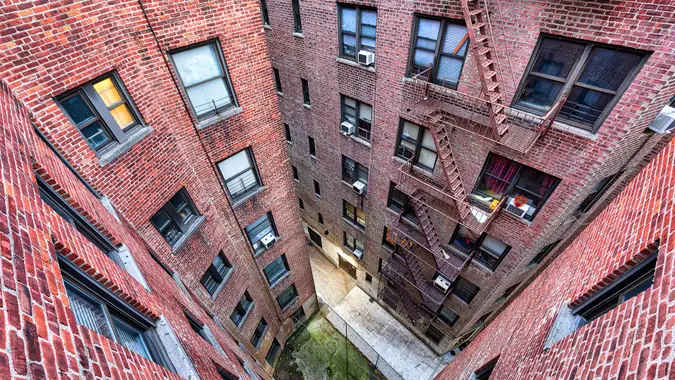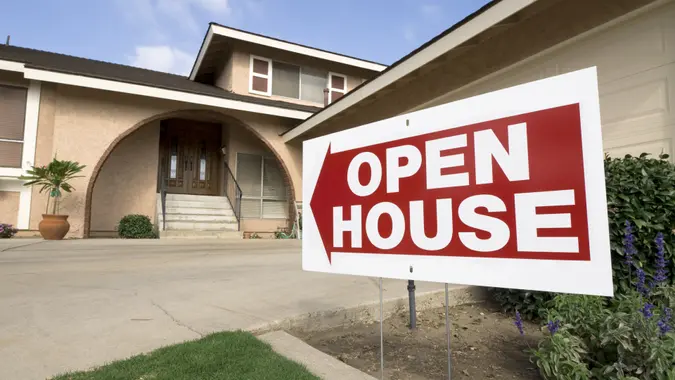Counting the True Price of Adhering to HOA Guidelines

Commitment to Our Readers
GOBankingRates' editorial team is committed to bringing you unbiased reviews and information. We use data-driven methodologies to evaluate financial products and services - our reviews and ratings are not influenced by advertisers. You can read more about our editorial guidelines and our products and services review methodology.

20 Years
Helping You Live Richer

Reviewed
by Experts

Trusted by
Millions of Readers
It’s been an arduous road for many homebuyers in the past few months. Inflation, exploding mortgage rates, low inventory and high prices have left many in search of their dream home on the sidelines.
Now, if you’re still in the market for a home and would also like to find one in a community with added features and shared amenities such as a gym, pool, tennis courts or landscaping maintenance, you might want to consider buying a home with a homeowners association (HOA).
What Is an HOA?
“HOAs, or homeowners associations, are fairly common today, with about one in three homes belonging to one,” said Realtor.com executive editor Judy Dutton, editor of Realtor.com’s “First-Time Homebuying 101” e-book. “Their main purpose is to protect and preserve property values, which they accomplish in two ways.”
One way is by charging their members HOA fees, which range from around $200 to $300 per month and may be put toward maintaining common areas such as a community gym, swimming pool or parking lot, said Dutton. The other way HOAs maintain a community’s appearance is by establishing rules known as Covenants, Conditions and Restrictions — or CC&Rs — that their members must follow to keep their homes looking their best, she added.
And these communities are on the rise — for instance, CNBC reported that 84% of newly built, single-family homes sold in 2022 belonged to homeowners associations.
But these homes also come with added costs and fees.
As Rocket Mortgage explained, living in a community run by an HOA can have its pros and cons.
“While the group’s governance might prevent you from doing exactly what you want with your property, the rules set in place are designed to preserve the neighborhood and help all the homes maintain their property values. Furthermore, the fees that HOA community residents typically pay are used to maintain the common areas and keep the entire neighborhood appealing,” according to Rocket Mortgage.
What Are You Paying For?
While amenities vary by community, common features of HOAs include the maintenance of these, such as swimming pools or gyms, as well as landscaping and garbage removal, for instance.
“Typically, HOAs do maintenance of common facilities, landscaping, snow removal and the like. Some even have airstrips!” said Jason Sorens, PhD, economist at American Institute for Economic Research. “In some of the largest HOAs, you may get a break in property taxes if the HOA is performing functions that a local government otherwise does.”
Other Considerations
Yet, there are some other considerations you should look into before buying a home in a HOA community.
Special Assessments
For instance, Sorens said you should check not just the guidelines and fees, but whether the HOA has a healthy fund for whatever maintenance might be required.
“Especially if you’re considering buying a condo in a common building. Unexpected maintenance needs could result in large ‘special assessments’ down the line,” he said.
Special assessments generally occur in the case of unexpected emergencies when the community needs major repairs.
It’s worth noting that they are separate from typical HOA costs like regular dues and planned HOA assessments, according to Rocket Mortgage, and unlike other costs, special assessments usually fall outside the HOA’s yearly budget — “potentially by a lot.”
Fines
As Dutton explained, homeowners who violate the so-called CC&Rs typically face fines, which may start at around $25, but then increase to $50, then $100 or $200, if you don’t pay or continue to violate the rule.
“That can add up fast, so it definitely pays to review these CC&Rs — ideally before you even buy the house, just to make sure you’re okay with following them,” she said.
Maintenance and Curb Appeal
Many of the most common HOA policies that will cost you time and money to adhere to have to do with the curb appeal of your house.
For instance, lawn maintenance is a big one, as the HOA might mandate that lawns get mowed regularly.
“While the cost will vary based on the size and terrain of your lawn, you can expect to spend around $50 on average. Of course, you could lower these costs by mowing the lawn yourself,” said Dutton.
Dutton added that some HOAs might also have rules on how often you paint your house or that it must be re-painted if it shows significant chipping or peeling.
“The cost to paint a house exterior averages at $3,087. Also keep in mind that an HOA might restrict which color you paint your exterior,” she said.
While HOA maintenance rules may often seem annoying for homeowners, it’s worth keeping in mind that their goal is to maintain your property’s value. Homeowners can also work to change these rules by presenting their case to the HOA board, ideally with other neighbors who feel the same way.
How Added Fees Can Take a Toll
Dave Flanders, owner and founder at HomeVisors Collective, said that most homeowners tend to overlook the true costs associated with HOA guidelines when buying a home.
According to him, HOA requirements, although they maintain community standards and property values, can add an unexpected layer of expense to homeownership.
“It’s not just about the aesthetic appeal of the home and the community but also about the financial implications of staying in compliance with these rules,” he said. “My primary goal is to always educate my clients about these types of things to make sure they [are informed] before making a decision.”
More From GOBankingRates
 Written by
Written by  Edited by
Edited by 

























